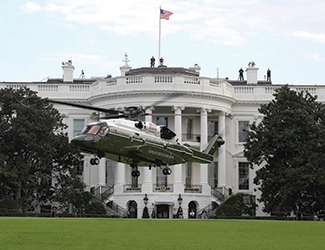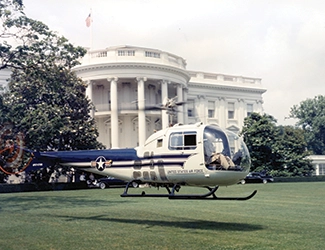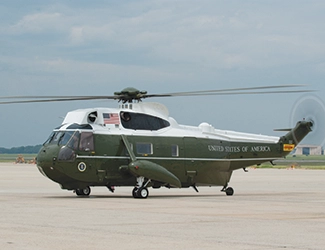VH-92A Patriot fielding complete
By Jay Chandler
ATP/Helo. Learjet, Short 330, Boeing 234 Chinook

Recently, in August this year, the Marine Corps accepted the delivery of the last VH-92A Patriot for HMX-1, the VIP unit which transports the President in Marine One. This event closed out the previous VH-3D Marine One helicopter, which started in 2002.
Two aircraft were submitted for the proposal, the Sikorsky S-92 and the Lockheed.Martin/ AgustaWestland US101. The Department of Defense awarded the contract for the US101 but due to extreme cost overruns, the contract was cancelled and the search for another helicopter began.
In 2012, a request for proposals was issued and in May 2014, the Navy awarded Sikorsky a contract to build the next presidential helicopter, the VH-92A Patriot, a derivative of the commercial S-92.
The newest executive helicopter is the last of 23 VH-92A helicopters for HMX-1. Currently, the Marine Corps operates 10 VH-3D’s, 6 VH-60Ns and 9 VH-92A’s that support various missions required of HMX-1.
Eisenhower takes first POTUS flight
Helicopters were first used by the US military in World War 2 when the Sikorsky R-4 began combat operations. By 1956, the Soviet Union’s nuclear capability was formidable and the ability to safely evacuate the President by ground transportation was in question, forcing the USAF to acquire a helicopter for the President.
The Bell H-13J was selected even though other larger helicopters were available. July 12, 1957, marked the first time a US President flew in a helicopter, flown by the USAF, a Bell H-13J (Bell 47J Ranger). President Eisenhower was flown with James Rowley, Chief of the White House Secret Service detail by Maj. Joseph Barrett from the South Lawn of the White House to Camp David.
When he arrived, he was drenched in sweat and arrived after larger and faster helicopters that launched from the White House after his departure, had passed him and landed prior to his arrival at Camp David.

Eisenhower’s next helicopter flight was on September 6, 1957 in a much larger Marine HUS-1, which Eisenhower found to be a vast improvement over the cramp, slow and hot ride of the Bell H-13J.
He ordered the military to switch to the larger CH-34, (Army designation of the Marine HUS-1) both the US Army and USMC began flying POTUS as Army One and Marine One, respectively, in 1958.
Both the Army and Marine units flew converted Sikorsky CH-34 Choctaws, designated VH-34. The VIP version featured an improved interior, instrumentation and navigation equipment, as well as, emergency flotation devices and a weak air conditioner (but who has ever heard of a robust air conditioner on an aircraft).
The distinguishing “white top” of the VIP helicopter was the result of an effort to keep the cabin cooler by using white paint to reflect the sun. This paint scheme remains to this day even with radical improvements in air conditioning.
With both the Army and Marines providing executive transport and the President not wanting to show favoritism, Eisenhower alternated between Army One and Marine One, which continued in executive transport until the Army Special Flight Detachment was shut down in 1976, during the Ford Administration and the Marines became the only helicopter transport for the Commander-in-Chief.

Most recognized POTUS helicopter
After almost two decades, the VH-34 executive helicopter needed an upgrade. The VH-3A entered service in 1961 followed by the VH-3D in 1974. Many improvements were made to the Sea Kings over the years, including defense measures and communication capabilities.
The VH-3 is a modified Sikorsky H-3 developed for antisubmarine warfare like the VH-34. For the executive role, the VH-3 was outfitted with carpet, telephones, upgraded communications capabilities, wet bar and toilet facilities.
The aircraft was also soundproofed and armored in critical areas with survivability improvements for all occupants. With all the technological advancements added to the overall weight of the aircraft, mission capability was reduced, few new improvements could be made. After Sep 11, 2001, it was determined Marine One needed substantially improved communications and security systems.
VH-92 Patriot
All VIP helicopters have evolved from military or utility platforms that have been modified for executive transport, the VH-92 is no different. The S-92 was originally designed to meet the requirements of long-haul offshore oil service, carrying large passenger loads. The S-92 was first certified by the FAA in 2002, and has been in production ever since. Many of the components are based on the S-70 (civilian version of the UH-60 Blackhawk).
One advantage the S-92 has over most helicopters (CH-47 not included) is its cavernous cabin, which is 20 ft 0 in long, 6 ft 7 in wide, and 6 ft 0 in high. The designers of the VH-92A had a lot of room to work with when creating the Presidential interior. The crashworthy fuselage, retractable landing gear and seats all designed to absorb energy during a hard landing. Other features include flaw tolerance, redundant systems, bird strike protection and EMI protection.

The avionics package includes Collins Aerospace Proline communication and navigation radios, 4 multifunction displays (MFDs), and 2 display control panels. It also integrates an enhanced ground proximity warning system (EGPWS), traffic collision avoidance system (TCAS) and weather radar.
In addition to the primary avionics package, secure and non-secure communications systems, and a robust threat defense package were added.
A problem with the communications systems and an issue with the engine exhaust burning the grass on the White House South Lawn delayed fully implementing the VH-92 operation, but both concerns have been resolved.
Civilian versions of the S-92 are designed for a crew of three and 19 passengers. The VH-92A will be operated by 2 pilots, 1 crewchief and a communications systems operator, leaving room for a 14 passenger VIP interior.
Two General Electric CT7-8A turboshaft engines and a Honeywell 36-150 APU are mounted on the VH-92A providing power to allow a 27,700 lb. max takeoff weight and emergency power from the APU. As a testament to the Sikorsky S-92’s success, Canada began replacing its CH-124 Sea King antisubmarine warfare helicopters in 2018 with a variant of the S-92 – the CH-148 Cyclone.
Like the Sea Kings, the VH-92A is fully transportable in a single C-17 or C-5 anywhere in the world. During missions with the Commander-in-Chief on board, multiple helicopters are used, sometimes up to five, to confuse any potential threats.
Six decades of Marine One
Since 1957, the Marine Corps has had the “no fail” mission to carry POTUS all over the world. HMX-1, based at NYG (Quantico MCAF, Quantico VA), has the burden of providing unparalleled short-haul service while constantly on-call and ready for action.
Now, VMX-1 has a whole new aircraft with increased capabilities and performance. On Aug 19, 2024, the Sikorsky VH-92A served officially as Marine One when they transported President Joe Biden for the first time in Chicago. Sikorsky helicopters have been serving POTUS for 6 decades, and the VH-92A looks set to keep that proud tradition flying well into the future.
 Jay Chandler has written for Pro Pilot since 1995, and has flown for FAA, military, and Part 91 and 135 operators throughout his 30-year career.
Jay Chandler has written for Pro Pilot since 1995, and has flown for FAA, military, and Part 91 and 135 operators throughout his 30-year career.